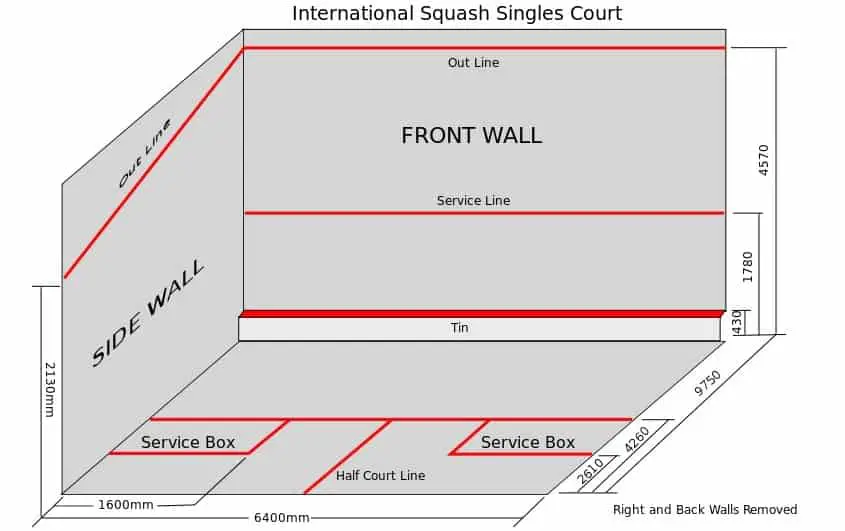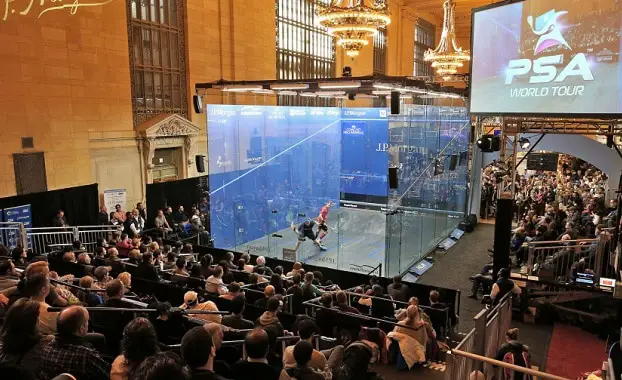Squash beginners often like to get the basic understanding of the squash rules and the passage below does just that. It is a quick guide on the basic squash rules which includes the court dimensions, what the lines mean and the serving, scoring and other rules.
Table of Content
The Court
Walls & Floor
The court consists of the front wall, the two side walls, the back wall and the floor.
Front Wall
The front wall has three parallel lines, all of which serve a different purpose. They are:
- Tin Line or Board
- Service Line
- Out Line
Player services need to be hit between the service line and the out line and after that, regular non-service play needs a player to hit the ball between the tin line and out line.
Also Read:
Floor
The floor consists of the following:
- Front Line or a Short Line: This line divides the court into two parts, the front part and the back part.
- Service Box: The service box is a part of the back portion of the floor, is a rectangular portion on the left and right side of the court.
- Half Court Line: This divides the back portion of the court into two rectangular halves.
Back Wall
The back wall consists of the following:
- Back Wall Line: This line runs parallel to the floor at 2.13 meters from it.
- Door: The door is located at the back of the court, and is around 90 X 213 cm in dimension. Players enter the court using this door.
Dimensions
A singles squash court is 9.75 meters long and 6.4 meters wide. The height of the ceiling from the floor needs to be at least 5.64 meters. In case of doubles, this changes to 13.7 X 7.6 meters.
Some of its other dimensions are as follows:
- The floor diagonal, i.e. from one corner to the opposite corner: 11.66 meters (15.7 meters in doubles)
- Height from floor to lower edge of front wall line or the out line: 4.57 meters (6.09 meters in doubles)
- Height from floor to lower edge of service line on front wall: 1.78 meters (2.46 meters in doubles)
- Height from floor to top of the tin: 0.48 meters (0.43 meters in doubles)
- Height from floor to lower edge of back wall line: 2.13 meters (2.13 meters in doubles)
- Distance between short line to back wall: 4.26 meters (4.57 meters in doubles)
- Service box dimensions: 1.6 X 1.6 meters (1.37 sq. meters in doubles)
- Width of lines: 5 cm (3.8 cm in doubles)
- Upper section of tin width: 5 cm (3.8 cm in doubles)
- Distance between half court line and either wall: 3.2 meters (3.8 meters in doubles)

Serving Rules
Service might not be the most important part of a squash player’s game but the rules surrounding the service must be adhered to obviously and player serving needs to ensure he/she makes it very tough for the opponent to return.
Singles Serving
Below are the serving rules in squash singles matches.
- The player winning the toss is allowed to decide which side of the court he/she wants to serve.
- Player winning the point retains the serve but has to alternate between left and right side of the court while serving.
- Serve changes hands after the non-serving player wins the point. In that case the new serving player can now decide which side to serve from.
- The player serving needs to have at least one foot inside the service box.
- The service needs to hit the front wall on the full, i.e. without bouncing and should hit the region between the service line and the out line. If the ball hits either the service line or the out line, it’s a fault.
- After hitting the wall, the ball must then land in the region behind the short line on the opponent’s half of the court. Again, if the ball lands on that line, it’s a fault.
- Unlike in tennis, a fault means the point is won by the opponent.
Also Read:
- Why is the Backhand Serve so Important in Squash?
- How to Overcome the Problem of Sweat While Playing Squash?
Doubles Serving
Doubles in squash has slightly different rules. They are mentioned below:
- Both doubles teams need to announce their order of serving at the start of the match which will remain the same throughout the match.
- The team winning the toss then starts serving with the first server and he/she continues to serve till his/her team keeps winning the points.
- The service changes hands when the receiving team wins the point and the nominated first server from that team starts the serve.
- Like before, he/she continues to serve till his/her team loses the point at which point the second server from the first team gets the serve.
- Like in singles, even while winning the points, the server must alternate between left and right serving boxes after deciding which side he/she wants to start from.
Scoring Rules
Currently, the scoring at the highest level in squash follows these rules. These rules can be tweaked based on the level of your play and other factors.
- The winner of each rally wins the point irrespective of whether he/she was serving or receiving.
- First player to 11 points with a difference of two points wins the game.
- If the score gets to 10-10, the game continues till a player gets a lead of two points in which case he/she wins the game.
- Matches are played to best-of-five games.
- The previous ways of scoring had games to 15 points with a difference of two points.
- There is also a English way of scoring in which points are played to nine points but only the serving player can win the point if he/she wins the rally. If the non-serving player wins the rally, he/she gets the opportunity to serve.
Let Rules
Squash is one of the only racket sports in which the players share the same side of the court. This means it’s only natural for interference and obstruction to occur as a part of the sport.
In case there’s an interference, the player who has been obstructed can appeal to the match referee for a let. It would then be up to the referee to adjudicate on whether or not the obstruction appeal was a valid one.
If the referee considers the degree of interference to be big enough, he/she can call a let and the point is replayed. On the other hand, if the referee doesn’t consider it to be big, a stroke can be awarded, which means the player who appealed for the let loses the point.
A stroke is also also awarded if an interfering player is deemed to have prevented the opponent’s ability to swing the racket. However, if there’s little to no interference in the eyes of the referee, no let is allowed.
If a shot hits a player before hitting the front wall, a let can be awarded. This typically happens when a ball travelling to the side wall hits the player or one that has hit the side wall and is then heading towards the front wall hits the player.
However, if the ball is travelling straight to the front wall and hits the opponent, it’s an interference, and a stroke is awarded against the player who was in the path of the ball.
Rallies can also be replayed in the following circumstances:
- The safety of a player is compromised as a result of the manner in which the ball is hit by the opponent
- An occurrence on or off the court distracts one of the players
- A serve is made when the receiver isn’t ready and doesn’t attempt to return the ball either
- Breaking of the ball in use
- Conditions related to the court make it tough for players
What is Turning in Squash?
If a player allows the ball to pass from his left side and hit it after it passes his right (or vice-versa), he/she is said to have ‘turned’ in squash. In case a striker has turned and hits the ball which then proceeds to hit the opponent, the rally is won by the opponent.
However, if the striker has turned and doesn’t go through with his shot because of the worry it might hit the opponent, a let is called.


